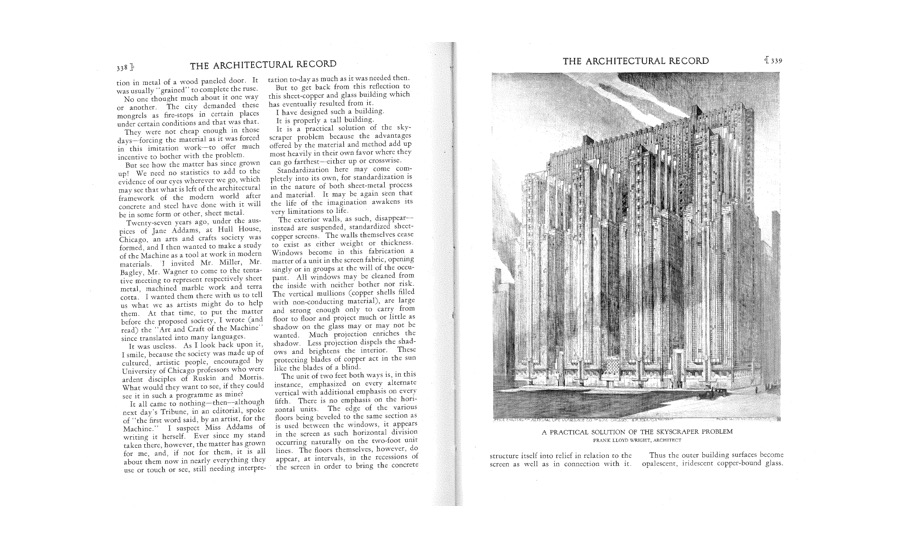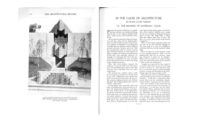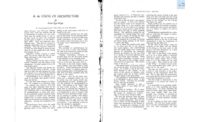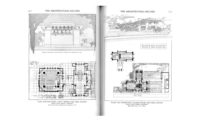Miller Brothers in addition to other offices of that factory were then interested in sheet metal window-sash and frames – especially in skylights and metal doors.
We had contempt for them because they were made to imitate wooden sash. The doors too were made up in wood and covered with metal, the result being an imitation in metal of a wood paneled door. It was usually “grained” to complete the ruse.
No one thought much about it one way or another. The city demanded these mongrels as fire-stops in certain places under certain conditions and that was that.
They were not cheap enough in those days – forcing the material as it was forced in this imitation work – to offer much incentive to bother with the problem.
But see how the matter has since grown up! We need no statistics to add to the evidence of our eyes wherever we go, which may see that what is left of the architectural framework of the modern world after concrete and steel have done with it will be in some form or other, sheet metal.
Twenty-seven years ago, under the auspices of Jane Addams, at Hull House, Chicago, an arts and crafts society was formed, and I then wanted to make a study of the Machine as a tool at work in modern materials. I invited Mr. Miller, Mr. Bagley, Mr. Wagner to come to the tentative meeting to represent respectively sheet metal, machined marble work and terra cotta. I wanted them there with us to tell us what we as artists might do to help them. At that time, to put the matter before the proposed society, I wrote (and read) the “Art and Craft of the Machine” since translated into many languages.
It was useless. As I look back upon it, I smile, because the society was made up of cultured, artistic people, encouraged by University of Chicago professors who were ardent disciples of Ruskin and Morris. What would they want to see, if they could see it in such a programme as mine?
It all came to nothing – then – although next day’s Tribune, in an editorial, spoke of “the first word said, by an artists for the Machine.” I suspect Miss Addams of writing it herself. Ever since my stand taken there, however, the matter has grown for me, and, if not for them, it is all about them now in nearly everything they use or touch or see, still needing interpretation to-day as much as it was needed then.
But to get back from this reflection to this sheet-copper and glass building which has eventually resulted from it.
I have designed such a building.
It is properly a tall building.
It is a practical soliton of the sky-scraper problem because the advantages offered by the material and method add up most heavily in their own favor where they can go farthest – either up or crosswise.
Standardization here may come completely into its own, for standardization is in the nature of both sheet-metal process and material. It may be again seen that the life of the imagination awakens its very limitations to life.
The exterior walls, as such, disappear- instead are suspended, standardized sheet-copper screens. The walls themselves cease to exist as either weight or thickness. Windows become in this fabrication a matter of a unit in the screen fabric, opening singly or in groups at the will of the occupant. All windows may be cleaned from the inside with neither bother nor risk. The vertical mullions (copper shells filled with non-conducting material), are large and strong enough only to carry from floor to floor and project much or little as shadow on the glass may or may not be wanted. Much projection enriches the shadow. Less projection dispels the shadows and brightens the interior. These protecting blades of copper act in the sun like blades of a blind.
The unit of two feet both ways is, in this instance, emphasized on every alternate vertical with additional emphasis on every fifth. There is no emphasis on the horizontal units. The edge of the various floors being beveled to the same section as is used between the windows, it appears in the screen as such horizontal division occurring naturally on the two-foot unit lines. The floors themselves, however, do appear, at intervals, in the recessions of the screen in order to bring the concrete structure itself into relive in relation to the screen as well as in connection with it.
Thus the outer building surfaces become opalescent, iridescent copper-bound glass.
To avoid all interference with the fabrication of the light-giving exterior screen the supporting pylons are set back from the lot line, the floors carried by them thus becoming cantilever slabs. The extent of the cantilever is determined by the use for which the building is designed. These pylons are continuous through all floors and in this instance exposed as pylons at the top. They are enlarged to carry electrical, plumbing, and heating conduits, which branch from the shafts, not in the floor slabs, but into piping designed into visible fixtures extending beneath each ceiling to where the outlets are needed in the office arrangement. All electrical or plumbing appliances may thus be disconnected and relocated at short notice with now waste it all in time or material.







